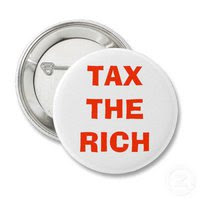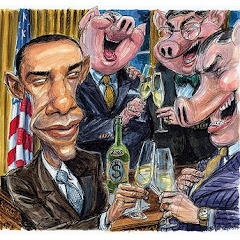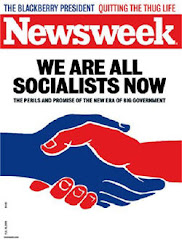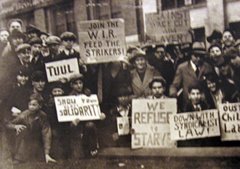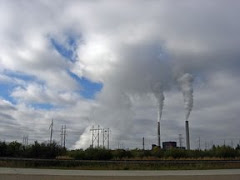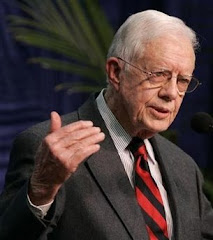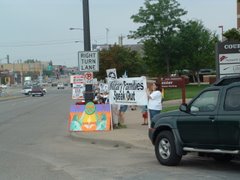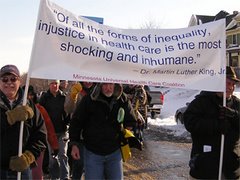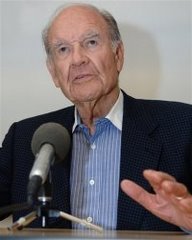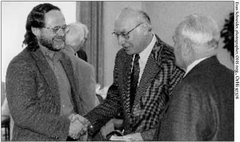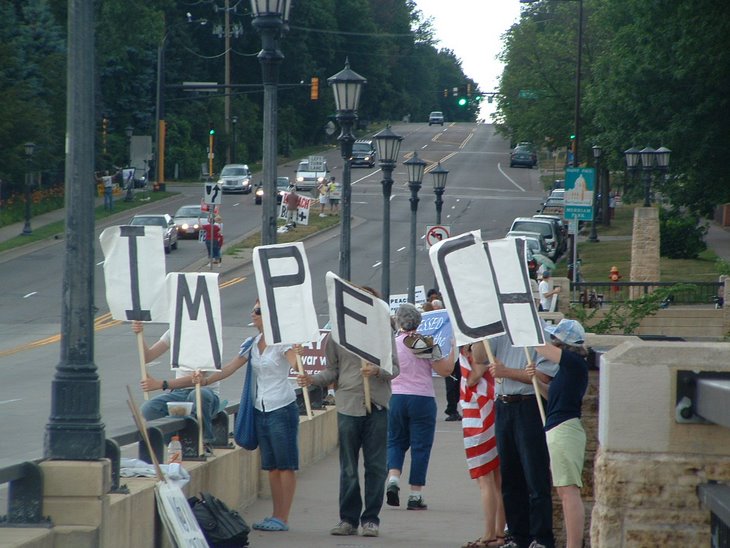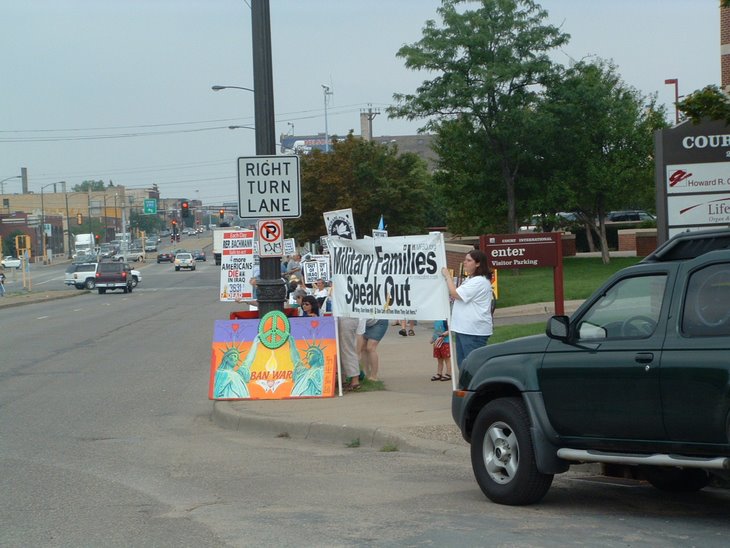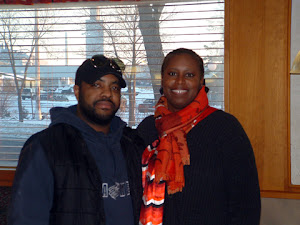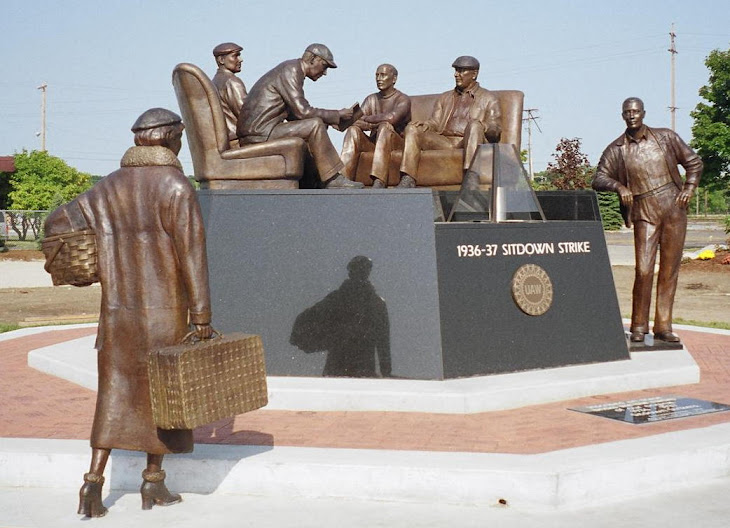Thursday, September 11, 2014
Working class families are trapped in a Wall Street "SNAFU."
I sent this "Letter to the Editor" to the Minneapolis Star Tribune in response to an article they published:
The headline in Nation+World read: Recession lingers in wages (Star Tribune, Sept. 9, 2014 page D3).
These low wages amid rising prices on everything from groceries to gas to home heating fuels and electric bills to health, car and home insurance and college tuitions result in a cost-of-living crisis for every working class family.
The government is enforcing poverty by failing to establish state and federal Minimum Wage laws in line with actual cost-of-living factors.
Poverty wages combined with this incessant senseless squandering of our Nation's wealth on militarism and wars which fuels inflation along with monopoly price fixing is destroying the livelihoods of working class families.
But this is what we get when we allow Wall Street to have a monopoly on political and economic power.
How else can one explain why it is that we have a government that can enforce poverty wages but can't stop the robbery at the gas pumps and rising prices at the grocery store?
All of this contributes to this cost-of-living crisis; this is why a "Recession lingers in wages."
We are trapped in a Wall Street SNAFU.
Alan L. Maki
Definition of "SNAFU:"
http://www.urbandictionary.com/define.php?term=SNAFU
Situation Normal, All Fucked Up
Link to article:
http://www.startribune.com/lifestyle/274359091.html
Note: The Minneapolis Star Tribune only published a digested version of this Associated Press article. Why?
And why doesn't the Minneapolis Star Tribune interview workers, the victims of poverty wages?
Is not losing one's job a "pay cut?"
5 years after Great Recession ended, stagnant pay remains economy's weakest link
Article by: CHRISTOPHER S. RUGABER ,
Associated Press Updated:
September 8, 2014 - 8:15 PM
WASHINGTON — The U.S. job market has steadily improved by pretty much every gauge except the one Americans probably care about most: Pay.
The unemployment rate has sunk to a nearly normal 6.1 percent. Employers have added a robust 2.5 million jobs the past 12 months. Layoffs have tumbled.
Yet most people are still waiting for a decent raise. Friday's August jobs report confirmed that average hourly pay has crept up only about 2 percent a year since the recession ended five years ago — barely above inflation and far below the gains in most recoveries.
Just why pay has been so weak and when it might strengthen are key issues for the Federal Reserve in deciding when to raise interest rates.
The trend has mystified analysts.
"This is the primary economic and policy puzzle facing policymakers right now: Why have wages remained so low in the face of an improving economy?" said Joe Brusuelas, chief economist at McGladrey, a tax and accounting firm.
Some economists expect pay to pick up eventually as the job market keeps improving. They think wages have lagged because millions of people are still out of work — many of whom aren't counted in the unemployment rate because they're no longer looking for a job.
But others say they fear that pay has stagnated because of trends that will persist even after the economy has moved closer to full health.
They note that companies have been making more use of temporary and part-time workers, usually at lower pay, to replace full-time permanent jobs. And newer technologies have enabled businesses to produce more with fewer employees.
A survey of Harvard Business School graduates released Monday lends weight to that notion. Nearly half the respondents said they'd rather invest in technology than in workers. Just over 40 percent expect wages and benefits to decline over the next three years.
Economists are flummoxed by the way the historical relationship between pay and unemployment has eroded since the recession ended. Based on historical trends, the steady drop in unemployment should have raised inflation-adjusted wages by 3.6 percent by June, according to researchers at the Federal Reserve Bank of Chicago. That's because employers have had to fill jobs from a smaller pool of unemployed people — a trend that normally forces them to pay more.
Instead, overall inflation-adjusted wages have essentially flattened since 2009.
That said, workers in some industries have fared better. For those in a category that includes data processing and analytics, as well as broadcasting, film and publishing, hourly wages have surged 4.6 percent in the past year. And pay is up at least 3 percent for financial services workers and wholesalers.
By contrast, wages are up just 1.3 percent for employees in education and health care.
So why has overall wage growth been so weak? Economists point to several factors.
The biggest is that there are still too many people desperate for work than is typical for a healthy economy. That makes it easier for employers to fill jobs without raising pay.
There are 227,000 fewer people with jobs than in November 2007, just before the recession began. Yet the working-age population is up 15.3 million since then. That's kept the number of unemployed elevated: 9.6 million Americans, up from 7.6 million when the recession began.
But it's not just unemployment that's holding down wages. The many part-timers who would prefer full-time work are also competing with those who are out of work. There are 7.2 million involuntary part-timers, up from just 4.6 million in late 2007.
Half the economists surveyed by The Associated Press last month cited the high number of people without full-time jobs as the main reason wage growth has been weak.
The Chicago Fed estimates that if all measures of unemployment, including involuntary part-timers, had returned to pre-recession levels, paychecks after inflation would now be rising up to 1 percentage point faster.
Given these trends, people who do have jobs have less leverage to demand higher pay. Sixteen percent of working Americans say their pay hasn't budged in the past year, up from 11 percent before the recession, according to research by Bank of America Merrill Lynch.
In a healthier economy, more people would seek higher pay elsewhere and quit their jobs once they found it. But the number who quit their jobs tumbled during the recession and has only partly recovered.
In addition, fewer startup companies are being created, holding back hiring. In the final quarter of 2013, new companies created just 1.3 million jobs, down from an average of 1.75 million in the 1990s, according to government data.
Fewer startups and fewer quits have reduced what's called job-market "churn." Economists liken churn to musical chairs: When people quit or new jobs are created by startups, more positions open for the unemployed or for workers seeking higher pay.
But churn has declined by up to one-third since the early 1990s, according to research by economists Steven Davis and John Haltiwanger.
Typically, wages also rise in line with increased productivity. Productivity measures output per hour of work, and higher productivity enables companies to pay more without sparking inflation. Yet productivity has been unusually sluggish the past three years.
Some economists are surprised that the recession didn't weaken Americans' pay even more than it did. So deep was the recession that many analysts assumed companies would reduce not only jobs but also wages.
The lack of pay cuts during the recession may help explain meager raises now. Having paid more than they typically would during the downturn, companies may now try to make up for lost ground by holding off on raises longer than usual.
The headline in Nation+World read: Recession lingers in wages (Star Tribune, Sept. 9, 2014 page D3).
These low wages amid rising prices on everything from groceries to gas to home heating fuels and electric bills to health, car and home insurance and college tuitions result in a cost-of-living crisis for every working class family.
The government is enforcing poverty by failing to establish state and federal Minimum Wage laws in line with actual cost-of-living factors.
Poverty wages combined with this incessant senseless squandering of our Nation's wealth on militarism and wars which fuels inflation along with monopoly price fixing is destroying the livelihoods of working class families.
But this is what we get when we allow Wall Street to have a monopoly on political and economic power.
How else can one explain why it is that we have a government that can enforce poverty wages but can't stop the robbery at the gas pumps and rising prices at the grocery store?
All of this contributes to this cost-of-living crisis; this is why a "Recession lingers in wages."
We are trapped in a Wall Street SNAFU.
Alan L. Maki
Definition of "SNAFU:"
http://www.urbandictionary.com/define.php?term=SNAFU
Situation Normal, All Fucked Up
Link to article:
http://www.startribune.com/lifestyle/274359091.html
Note: The Minneapolis Star Tribune only published a digested version of this Associated Press article. Why?
And why doesn't the Minneapolis Star Tribune interview workers, the victims of poverty wages?
Is not losing one's job a "pay cut?"
5 years after Great Recession ended, stagnant pay remains economy's weakest link
Article by: CHRISTOPHER S. RUGABER ,
Associated Press Updated:
September 8, 2014 - 8:15 PM
WASHINGTON — The U.S. job market has steadily improved by pretty much every gauge except the one Americans probably care about most: Pay.
The unemployment rate has sunk to a nearly normal 6.1 percent. Employers have added a robust 2.5 million jobs the past 12 months. Layoffs have tumbled.
Yet most people are still waiting for a decent raise. Friday's August jobs report confirmed that average hourly pay has crept up only about 2 percent a year since the recession ended five years ago — barely above inflation and far below the gains in most recoveries.
Just why pay has been so weak and when it might strengthen are key issues for the Federal Reserve in deciding when to raise interest rates.
The trend has mystified analysts.
"This is the primary economic and policy puzzle facing policymakers right now: Why have wages remained so low in the face of an improving economy?" said Joe Brusuelas, chief economist at McGladrey, a tax and accounting firm.
Some economists expect pay to pick up eventually as the job market keeps improving. They think wages have lagged because millions of people are still out of work — many of whom aren't counted in the unemployment rate because they're no longer looking for a job.
But others say they fear that pay has stagnated because of trends that will persist even after the economy has moved closer to full health.
They note that companies have been making more use of temporary and part-time workers, usually at lower pay, to replace full-time permanent jobs. And newer technologies have enabled businesses to produce more with fewer employees.
A survey of Harvard Business School graduates released Monday lends weight to that notion. Nearly half the respondents said they'd rather invest in technology than in workers. Just over 40 percent expect wages and benefits to decline over the next three years.
Economists are flummoxed by the way the historical relationship between pay and unemployment has eroded since the recession ended. Based on historical trends, the steady drop in unemployment should have raised inflation-adjusted wages by 3.6 percent by June, according to researchers at the Federal Reserve Bank of Chicago. That's because employers have had to fill jobs from a smaller pool of unemployed people — a trend that normally forces them to pay more.
Instead, overall inflation-adjusted wages have essentially flattened since 2009.
That said, workers in some industries have fared better. For those in a category that includes data processing and analytics, as well as broadcasting, film and publishing, hourly wages have surged 4.6 percent in the past year. And pay is up at least 3 percent for financial services workers and wholesalers.
By contrast, wages are up just 1.3 percent for employees in education and health care.
So why has overall wage growth been so weak? Economists point to several factors.
The biggest is that there are still too many people desperate for work than is typical for a healthy economy. That makes it easier for employers to fill jobs without raising pay.
There are 227,000 fewer people with jobs than in November 2007, just before the recession began. Yet the working-age population is up 15.3 million since then. That's kept the number of unemployed elevated: 9.6 million Americans, up from 7.6 million when the recession began.
But it's not just unemployment that's holding down wages. The many part-timers who would prefer full-time work are also competing with those who are out of work. There are 7.2 million involuntary part-timers, up from just 4.6 million in late 2007.
Half the economists surveyed by The Associated Press last month cited the high number of people without full-time jobs as the main reason wage growth has been weak.
The Chicago Fed estimates that if all measures of unemployment, including involuntary part-timers, had returned to pre-recession levels, paychecks after inflation would now be rising up to 1 percentage point faster.
Given these trends, people who do have jobs have less leverage to demand higher pay. Sixteen percent of working Americans say their pay hasn't budged in the past year, up from 11 percent before the recession, according to research by Bank of America Merrill Lynch.
In a healthier economy, more people would seek higher pay elsewhere and quit their jobs once they found it. But the number who quit their jobs tumbled during the recession and has only partly recovered.
In addition, fewer startup companies are being created, holding back hiring. In the final quarter of 2013, new companies created just 1.3 million jobs, down from an average of 1.75 million in the 1990s, according to government data.
Fewer startups and fewer quits have reduced what's called job-market "churn." Economists liken churn to musical chairs: When people quit or new jobs are created by startups, more positions open for the unemployed or for workers seeking higher pay.
But churn has declined by up to one-third since the early 1990s, according to research by economists Steven Davis and John Haltiwanger.
Typically, wages also rise in line with increased productivity. Productivity measures output per hour of work, and higher productivity enables companies to pay more without sparking inflation. Yet productivity has been unusually sluggish the past three years.
Some economists are surprised that the recession didn't weaken Americans' pay even more than it did. So deep was the recession that many analysts assumed companies would reduce not only jobs but also wages.
The lack of pay cuts during the recession may help explain meager raises now. Having paid more than they typically would during the downturn, companies may now try to make up for lost ground by holding off on raises longer than usual.
Subscribe to:
Comments (Atom)



























